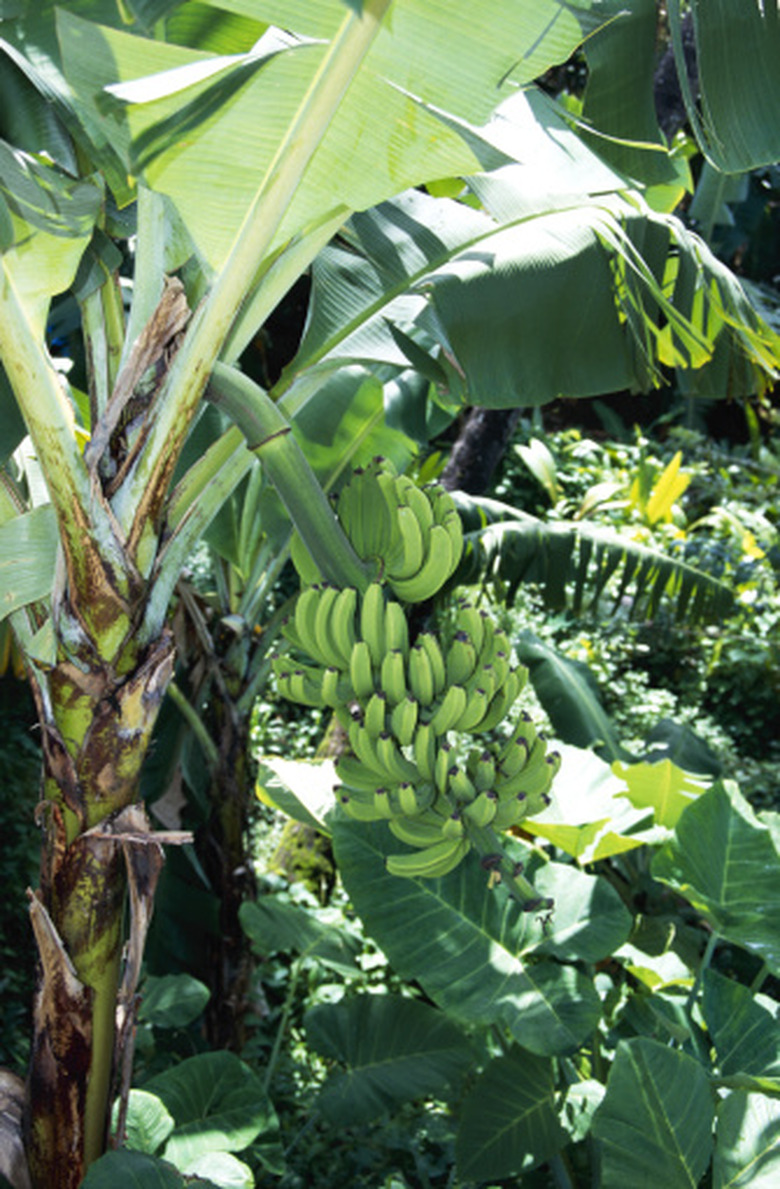Banana Tree And Its Uses
The banana (Musa spp.) is not technically a tree but is instead a large herb. Bananas are grown in large-scale fruit production in warm climates, but ornamental bananas with varied growth habits and fruit characteristics are commonly grown as houseplants in temperate climates. With proper cultural care and acceptable environmental conditions, bananas should be able to yield fruit that may, depending on the specific banana type, be palatable. Banana plants may also be used for a number of non-food purposes.
Description
Unlike trees, the banana has a succulent, juicy pseudostem that emerges from a fleshy corm in the ground from which multiple suckers grow. The banana plant has smooth, tender leaves arranged in a spiral around the stem. Depending on the species or hybrid, leaves can be up to 9 feet long and may be entirely green or variegated. Male and female flowers are borne in a cluster at the tip of the stem; female flowers eventually mature into the banana fruits.
- is not technically a tree but is instead a large herb.
- Depending on the species or hybrid, leaves can be up to 9 feet long and may be entirely green or variegated.
Cultural and Environmental Care
Bananas prefer rich, fertile soils and a sunny, sheltered location. These plants thrive under uniformly warm or hot conditions. Plant growth slows if temperatures fall below 60 degrees Fahrenheit, and irreversible freeze damage may occur below 32 degrees. High winds can cause leaf shredding and drying and may topple plants. Banana plants require ample water and will suffer if the soil dries out; however, they are not flood tolerant. Each stem only produces flowers and fruits once, so the active stem must be cut away to allow new suckers to emerge.
Common Pests and Diseases
Banana plants, whether grown indoors or on a plantation, may be bothered by a number of pests and pathogens. Nematodes are often a major problem and are best controlled with nematicides, repeated plowing and sun exposure or crop rotation. Additionally, corms should be disinfected in hot water solutions before planting. Other banana pests include the black weevil and various species of thrips and mites. Several fungi, bacteria and viruses can attack banana plants, causing the development of symptoms that range from leaf spots or streaks to rotting fruit or roots.
- Bananas prefer rich, fertile soils and a sunny, sheltered location.
- Banana plants require ample water and will suffer if the soil dries out; however, they are not flood tolerant.
Food Uses
All banana plants can produce edible fruit, but the fruit taste, seediness, color, size and other characteristics depend on the species or variety. Bananas can be peeled and eaten raw, baked peeled or unpeeled, made into a puree suitable for infants and used in many other ways. In addition to this plant's highly versatile fruit, peeled stems can be chopped and added to salads or steamed with other vegetables.
Non-Food Uses
Banana leaves are commonly used as plants, for wrapping food and as an eye-shade or for protection from rain. The banana pseudostem can be utilized for its fiber. The pulp can be used to manufacture rope, paper, place mats and other goods, but the pseudostem is often most valuable economically if it is chopped and left in a field for its organic matter content. All parts of the banana have medicinal value. For example, flowers can be cooked and eaten by diabetics or used for bronchitis, dysentery and ulcers. Plant sap can be taken internally or applied externally to stings and bites. The young leaves can be used as a poultice for skin irritations. The roots, ashes of peels and leaves and seed mucilage also serve medicinal purposes in some regions and cultures.
- All banana plants can produce edible fruit, but the fruit taste, seediness, color, size and other characteristics depend on the species or variety.
- The young leaves can be used as a poultice for skin irritations.
References
- Purdue University Agriculture: "Fruits of Warm Climates — Banana"; Julia F. Morton; 1987
- "What Herb is That?"; John Hemphill and Rosemary Hemphill; 1990
- University of Florida IFAS Extension: "Banana Growing in the Florida Home Landscape"; Jonathan H. Crane, Carlos F. Balerdi and Ian Maguire; October 2008
- Texas AgriLife Extension Service: Home Fruit Production — Banana
